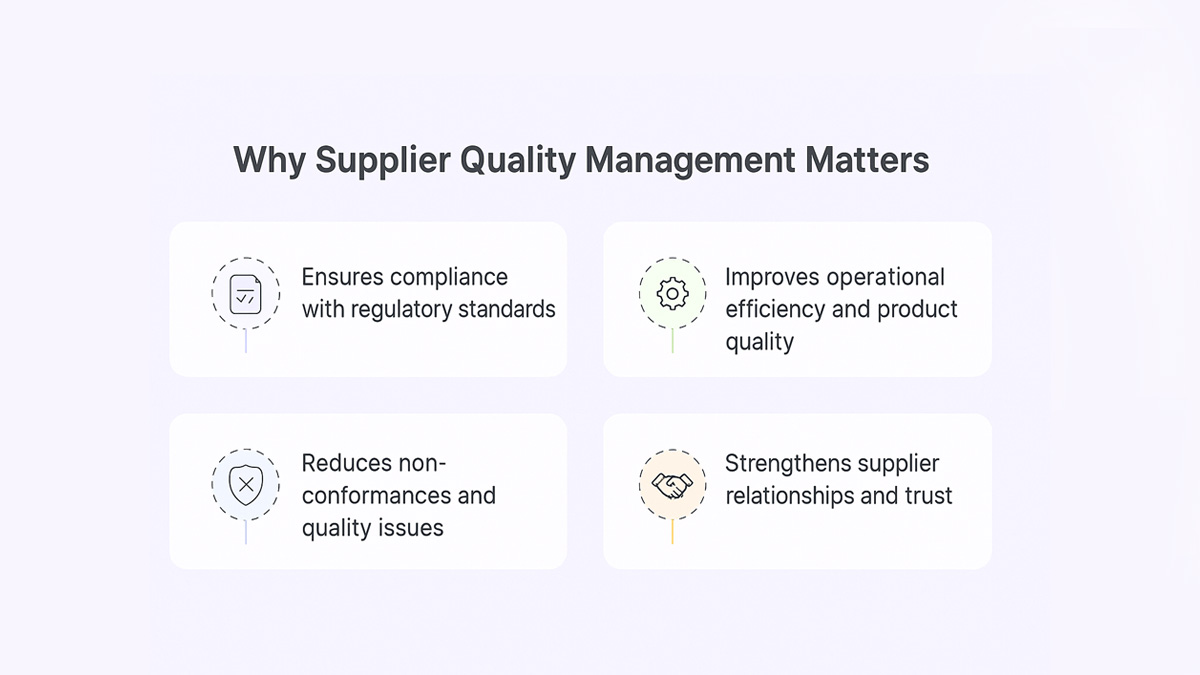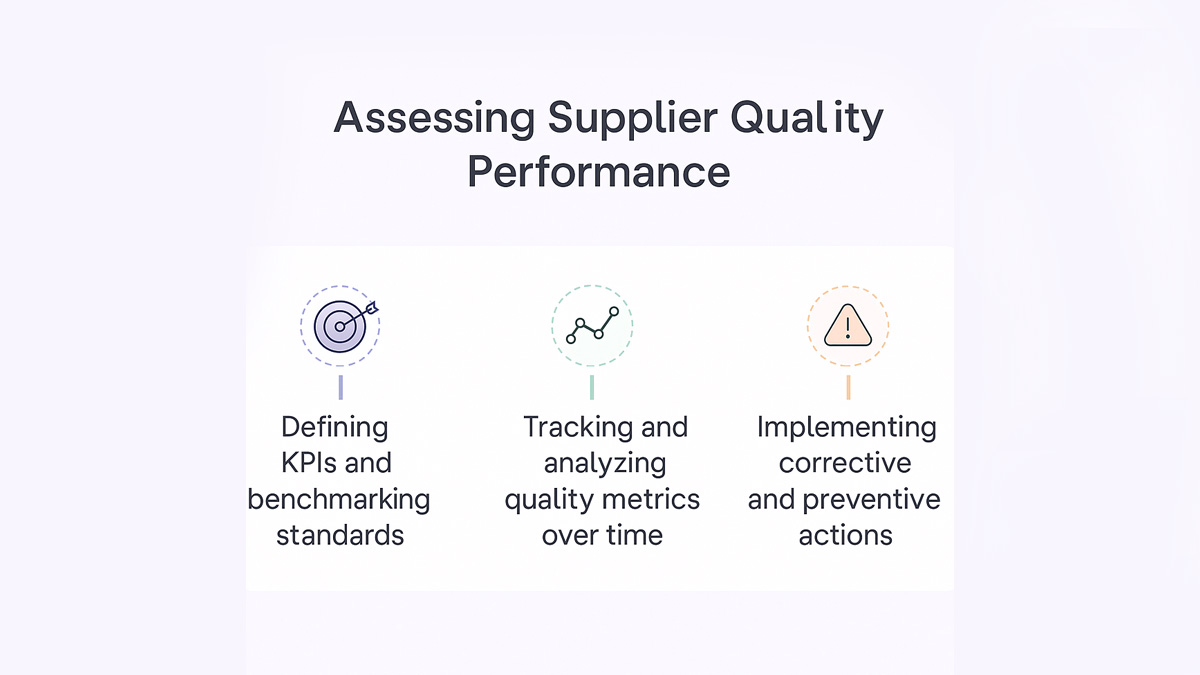

A Guide to Supplier Quality Management

A Guide to Supplier Quality Management
Learn how to evaluate, manage, and improve supplier quality to boost compliance, reduce risk, and streamline your supply chain.


Ever had a dish ruined because one ingredient didn’t hold up? That’s what a bad supplier can do to your entire supply chain. In today’s competitive landscape - especially in manufacturing or industries with strict regulatory standards - supplier quality management isn’t just a checkbox. It’s the glue that holds everything together.
Whether you're rolling out a new product line or scaling operations, poor supplier performance can lead to defects, delays, or compliance nightmares. That’s why businesses are doubling down on quality - right at the source.
What this blog will cover:
- What is supplier quality management?
- Why supplier quality management matters in the supply chain
- Key components of an effective supplier quality management program
- Evaluating and selecting the right suppliers
- How to assess supplier quality performance
- What to consider when choosing SQM software
- How Spendflo helps with supplier quality management
- Frequently asked questions on supplier quality management
What is Supplier Quality Management?
Supplier quality management (SQM) is the process of ensuring that a company’s suppliers consistently deliver goods or services that meet predefined quality standards. It involves qualification, monitoring, and corrective actions to minimize risks, ensure compliance, and maintain product reliability.
Why Supplier Quality Management Matters in the Supply Chain
Supplier quality management ensures vendors consistently meet required standards, helping businesses avoid disruptions, maintain compliance, and deliver high-quality products. It's a key pillar of supply chain performance - especially in regulated or quality-critical industries.

Ensures Compliance With Regulatory Standards
In highly regulated industries like pharmaceuticals, aerospace, and food manufacturing, compliance isn’t optional - it’s critical. A single supplier misstep can result in failed audits, legal penalties, or product recalls. Supplier quality management (SQM) ensures vendors adhere to necessary regulatory standards, helping businesses maintain their licenses, avoid disruptions, and pass audits with confidence.
Improves Operational Efficiency and Product Quality
SQM doesn’t just catch issues - it prevents them. By embedding inspections, audits, and preventive actions (CAPAs) into the supplier workflow, companies can detect problems early and avoid costly rework. This proactive approach reduces bottlenecks, minimizes defects, and keeps production lines moving efficiently.
Reduces Non-Conformances and Quality Issues
Every quality issue that makes it downstream - whether it’s a missing specification, faulty component, or contamination risk - creates delays and expenses. A robust SQM program establishes clear expectations, documentation, and controls to reduce non-conformances at the source, keeping your supply chain clean and consistent.
Strengthens Supplier Relationships and Trust
Suppliers aren’t just transactional partners; they’re part of your value chain. Transparent quality processes create better communication and accountability, fostering strong supplier relationships over the long term. When market conditions shift, trusted suppliers are more likely to prioritize your needs - and help you adapt faster.
Key Components of an Effective Supplier Quality Management Program
A strong supplier quality management (SQM) program isn’t just about ticking boxes - it’s a framework that brings consistency, accountability, and control to the supplier ecosystem.
Here are four core building blocks every SQM program needs.
Supplier Qualification and Onboarding
Before a supplier even ships their first product, they need to be vetted thoroughly. This includes reviewing supplier quality certifications, conducting site audits, and validating their ability to meet your quality standards. A structured onboarding process lays the foundation for success and ensures alignment from day one.
Performance Monitoring and Continuous Assessment
Ongoing evaluation is critical. This means tracking key quality metrics like defect rates, delivery timeliness, and audit results. Regular supplier scorecards and supplier audit results help identify trends - both positive and negative - and allow you to proactively address issues before they escalate.
Non-Conformance Management and CAPAs
Mistakes happen. What matters is how they’re handled. When a supplier falls short, there must be a clear process for issuing non-conformance reports (NCRs), conducting root cause analysis, and implementing corrective and preventive actions (CAPAs) that actually stick.
Audits, Inspections, and Documentation Control
A well-structured supplier audit program with scheduled and random inspections keeps suppliers accountable. They also ensure compliance with regulatory standards and customer specifications. Accurate documentation management - including quality records, certifications, and test results - ties everything together for full traceability.
Evaluating and Selecting the Right Suppliers
Choosing the right supplier isn’t just about cost - it’s about trust, reliability, and long-term alignment. The evaluation and selection process is your first line of defense against future quality issues, delays, or compliance headaches.
Criteria for Supplier Selection and Evaluation
Start with the essentials. Can the supplier meet your technical specifications and align with your supplier selection criteria? Do they comply with industry-specific regulatory standards? Beyond the basics, assess financial stability, scalability, location, and how well their internal quality systems align with yours. A supplier might offer a great price, but if they can’t consistently deliver on quality, it’s a costly tradeoff in the long run.
Balancing Cost, Quality, and Reliability
The lowest bidder doesn’t always win - nor should they. A supplier that requires constant hand-holding or delivers sub-par products can drive up total costs quickly. High-performing suppliers might cost more upfront, but the long-term savings in reduced non-conformances, fewer delays, and better operational flow make up for it. It’s about finding the right value, not just the right price.
Managing Supplier Risks and Non-Conformance Trends
A big part of supplier evaluation is understanding potential risks. Look at past performance - missed shipments, frequent quality issues, or failed audits are red flags. Use tools like risk scoring models, site visits, or historical trend analysis to get a full picture. And don’t forget to assess how responsive
responsive suppliers show improvement
How to Assess Supplier Quality Performance
You can’t manage what you don’t measure - and supplier quality is no exception. Assessing performance isn’t just a one-time checkbox; it’s an ongoing process that keeps standards high and surprises low.

Defining KPIs and Benchmarking Standards
Start by setting clear, measurable KPIs that reflect your business goals and compliance needs. These might include defect rates, on-time delivery, CAPA closure timelines, audit scores, or how quickly suppliers respond to non-conformance reports. Use these KPIs as benchmarks across all vendors to create a level playing field for performance comparisons.
Tracking and Analyzing Quality Metrics Over Time
Collecting data is one thing - acting on it is what makes the difference. Use dashboards or supplier scorecards for aspects of supplier quality and visualize trends like defect rates and time delivery over weeks, months, or quarters. A sudden spike in late deliveries or recurring quality issues could point to deeper problems - maybe a new production line, staff turnover, or lack of training. Regular check-ins and proactive actions help catch these changes early.
Implementing Corrective and Preventive Actions
When things go wrong, the next step matters. Instead of finger-pointing, dive into root cause analysis and build collaborative CAPAs. Preventive actions are just as important - they keep issues from repeating. Strong suppliers take this feedback seriously and treat it as an opportunity to improve, not a penalty.
In the end, supplier performance assessment isn’t just a report - it’s a roadmap to continuous improvement and stronger partnerships.
What to Consider When Choosing SQM Software
Not all supplier quality management software is built the same - and choosing the wrong one can create more work than it solves. The right tool should simplify processes, not complicate them.
Core Features to Look For
At a minimum, your SQM platform should support supplier onboarding, quality audits, non-conformance tracking, and performance scorecards. Bonus points if it includes tools for documentation management, automated reminders for supplier reviews, and configurable workflows. Think of it as your control tower for supplier quality - if it can’t centralize your efforts, it’s not doing its job.
Integration With Other Quality and Procurement Tools
Your SQM software shouldn't exist in a silo. Look for tools that integrate seamlessly with your existing ERP, procurement system, or inventory management platform. This connectivity enables real-time insights across teams - QA, procurement, and even finance - making collaboration smoother and decision-making faster.
Scalability, Usability, and Compliance Support
You want a solution that grows with you. As your supplier base expands or compliance needs evolve, your SQM tool should adapt - without a complete overhaul. Equally important is ease of use. If your team dreads logging in, adoption will stall. A clean, intuitive interface makes all the difference. And for industries under strict regulatory pressure (like life sciences or food), ensure the tool supports audit trails, electronic signatures, and documentation versioning.
At the end of the day, good SQM software should feel like an extension of your team - not a barrier.
How Spendflo Helps With Supplier Quality Management
Spendflo empowers businesses to build stronger supplier relationships by enabling the transformative power of visibility, control, and structure to the procurement process. With centralized dashboards and automated workflows, teams can easily track supplier performance, compliance milestones, and contract terms - all in one place.
By eliminating silos between procurement and quality, Spendflo ensures better collaboration, between procurement and quality, Spendflo ensures better collaboration, fewer missed renewals, and proactive supplier engagement. Whether you're onboarding new vendors or optimizing existing ones, Spendflo helps you manage risk, reduce costs,
Frequently Asked Questions on Supplier Quality Management
What is the role of audits in supplier quality management?
Audits help verify whether a supplier is meeting agreed-upon standards, both regulatory and operational. They provide insights into processes, documentation, and compliance gaps - allowing businesses to correct issues early and maintain trust.
How do companies evaluate supplier performance effectively?
Most companies use a combination of KPIs, such as defect rates, on-time delivery, and CAPA responsiveness. These KPIs help define the level of performance needed for suppliers to remain in good standing. Regular scorecards, inspections, and reviews help maintain consistent quality while identifying areas for improvement.
What’s the difference between quality control and quality assurance in supplier management?
Quality control focuses on detecting defects in products already made, while quality assurance is about designing processes to prevent those defects from happening in the first place. Both are critical in SQM.
Can SQM help reduce product recalls and returns?
Absolutely. By ensuring suppliers consistently meet your standards, SQM reduces the chance of faulty products reaching customers - which in turn minimizes recalls, returns, and damage to your brand.
What features should I look for in SQM software?
Look for supplier onboarding, audit tracking, non-conformance reporting, CAPA workflows, and integrations with ERP or procurement tools. A user-friendly interface and compliance support are also key.
How does supplier quality management improve customer satisfaction and supply chain management?
By ensuring consistent quality, timely deliveries, and compliance from vendors, supplier quality management enhances customer satisfaction and builds resilience into supply chain management. It reduces disruptions, improves product outcomes, and creates a more predictable supply flow.
Why are data-driven decisions important for efficient operations and long-term value creation?
Data-driven decisions allow teams to identify issues early, monitor suppliers in terms of performance, and act proactively. This leads to efficient operations, better risk management, and sustainable value creation especially critical for a food manufacturer or any quality-sensitive industry.










.png)




.png)










.avif)





